Items
Tag
Modern
-
 Prometheus Bound + Prometheus Unbound “This book contains two major works. The first is the Aeschylus play, Prometheus Bound, masterfully translated by Percy Bysshe Shelley and his cousin, Thomas Medwin. The second is Shelley's own poem, Prometheus Unbound, which is considered his masterpiece.”
Prometheus Bound + Prometheus Unbound “This book contains two major works. The first is the Aeschylus play, Prometheus Bound, masterfully translated by Percy Bysshe Shelley and his cousin, Thomas Medwin. The second is Shelley's own poem, Prometheus Unbound, which is considered his masterpiece.” -
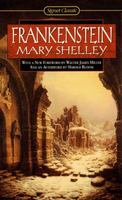 Frankenstein “At once a Gothic thriller, a passionate romance, and a cautionary tale about the dangers of science, Frankenstein tells the story of committed science student Victor Frankenstein. Obsessed with discovering the cause of generation and life and bestowing animation upon lifeless matter, Frankenstein assembles a human being from stolen body parts but; upon bringing it to life, he recoils in horror at the creature's hideousness. Tormented by isolation and loneliness, the once-innocent creature turns to evil and unleashes a campaign of murderous revenge against his creator, Frankenstein.”
Frankenstein “At once a Gothic thriller, a passionate romance, and a cautionary tale about the dangers of science, Frankenstein tells the story of committed science student Victor Frankenstein. Obsessed with discovering the cause of generation and life and bestowing animation upon lifeless matter, Frankenstein assembles a human being from stolen body parts but; upon bringing it to life, he recoils in horror at the creature's hideousness. Tormented by isolation and loneliness, the once-innocent creature turns to evil and unleashes a campaign of murderous revenge against his creator, Frankenstein.” -
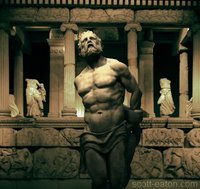 Prometheus and Digital Sculpture “The piece is my [Eaton’s] own interpretation of the Prometheus myth, and is not based on any existing sculptures.”
Prometheus and Digital Sculpture “The piece is my [Eaton’s] own interpretation of the Prometheus myth, and is not based on any existing sculptures.” -
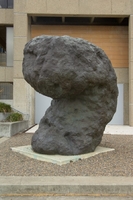 Prometheus (for Franz Kafka) “Tucker was a leading member of the New Generation of sculptors in London in the mid sixties. Their influence on Australian steel sculpture has continued to the present. Tucker however has moved on to other media and very different forms. This vast sculpture was made in plaster and cast directly in bronze. It suggests animated form being drawn up out of the earth. The cloud like volume may be seen as humanoid or as primal matter. Unlike other contemporary artists making large scale bronzes the original was modelled full size by the artist and not enlarged by technological processes. The surface is therefore a direct impression of the making process and the artist's gestures.”
Prometheus (for Franz Kafka) “Tucker was a leading member of the New Generation of sculptors in London in the mid sixties. Their influence on Australian steel sculpture has continued to the present. Tucker however has moved on to other media and very different forms. This vast sculpture was made in plaster and cast directly in bronze. It suggests animated form being drawn up out of the earth. The cloud like volume may be seen as humanoid or as primal matter. Unlike other contemporary artists making large scale bronzes the original was modelled full size by the artist and not enlarged by technological processes. The surface is therefore a direct impression of the making process and the artist's gestures.” -
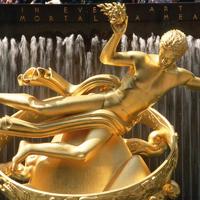 Prometheus “Prometheus is said to be the best-known sculpture in Rockefeller Center and the most photographed monumental sculpture in all of NYC. Created by famed American sculptor Paul Manship, who held a great fascination for mythological subjects and events, it has become the main attraction of the Lower Plaza. Its central theme is best stated by the quote that’s carved in the red granite wall behind him, taken from the sixth-century B.C. Greek dramatist Aeschylus: ‘Prometheus, Teacher in Every Art, Brought the Fire That Hath Proved to Mortals a Means to Mighty Ends.’”
Prometheus “Prometheus is said to be the best-known sculpture in Rockefeller Center and the most photographed monumental sculpture in all of NYC. Created by famed American sculptor Paul Manship, who held a great fascination for mythological subjects and events, it has become the main attraction of the Lower Plaza. Its central theme is best stated by the quote that’s carved in the red granite wall behind him, taken from the sixth-century B.C. Greek dramatist Aeschylus: ‘Prometheus, Teacher in Every Art, Brought the Fire That Hath Proved to Mortals a Means to Mighty Ends.’” -
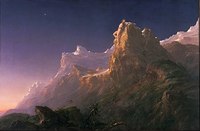 Prometheus Bound “In classical mythology, Prometheus was an immortal giant who aided the human race by stealing fire from the gods. As punishment he was chained to Mount Caucasus in Scythia and condemned to have his liver plucked out by a vulture each day, only to have it renewed and then devoured again the next. Thomas Cole is best known as a landscape painter, and here the figure of Prometheus—the ostensible main subject of the painting—is secondary to the vast mountain range that surrounds him. Research suggests that Cole, an abolitionist, may have chosen this subject to create a moral allegory of the evils of slavery, symbolized most potently by the shackles that bind Prometheus to the rock.”
Prometheus Bound “In classical mythology, Prometheus was an immortal giant who aided the human race by stealing fire from the gods. As punishment he was chained to Mount Caucasus in Scythia and condemned to have his liver plucked out by a vulture each day, only to have it renewed and then devoured again the next. Thomas Cole is best known as a landscape painter, and here the figure of Prometheus—the ostensible main subject of the painting—is secondary to the vast mountain range that surrounds him. Research suggests that Cole, an abolitionist, may have chosen this subject to create a moral allegory of the evils of slavery, symbolized most potently by the shackles that bind Prometheus to the rock.” -
 Prometheus, naked, chained to a rock, looking up at an eagle standing over him N/A
Prometheus, naked, chained to a rock, looking up at an eagle standing over him N/A -
 Prometheus Bound “In Greek mythology the Titan Prometheus stole fire from the gods on Mount Olympus to give to humanity. Furious, Zeus, king of the Olympians, ordered Prometheus forever chained to a rock, where each day an eagle would devour the Titan’s perpetually regenerating liver. This painting, which Rubens considered one of his most important works, represents the virtuoso artist at his absolute height. Working in collaboration, a common practice for master artists in Antwerp in the first two decades of the seventeenth century, Rubens and the famed animal and still-life painter Frans Snyders, who contributed the eagle, rendered the brutal tale of Prometheus with corresponding violence. The enormous bird’s beak rips open the Titan’s torso, exposing blood-soaked entrails. To gain purchase on the captive’s flesh, one of the eagle’s talons gouges Prometheus’s right eye. His left eye is locked on the predator, signaling he is fully aware of his torture, while his writhing legs, clenched fist, and tousled hair convey the Titan’s abject agony. Rubens, who intensively had studied the art he saw on his travels to Italy, Spain, and England, derived the hulking figure of Prometheus, with its broad frame and dense musculature, from prototypes by Michelangelo. The picture’s asymmetrical composition, in which Prometheus tumbles downward with his left arm almost reaching beyond the canvas, was inspired by a painting by Titian of the giant Tityus (1548–49; Museo del Prado, Madrid). Here Rubens masterfully synthesized and melded these sources with his own Baroque sensibilities. Christopher Atkins, from Philadelphia Museum of Art: Handbook. Philadelphia: Philadelphia Museum of Art, 2014, pp. 126–127.”
Prometheus Bound “In Greek mythology the Titan Prometheus stole fire from the gods on Mount Olympus to give to humanity. Furious, Zeus, king of the Olympians, ordered Prometheus forever chained to a rock, where each day an eagle would devour the Titan’s perpetually regenerating liver. This painting, which Rubens considered one of his most important works, represents the virtuoso artist at his absolute height. Working in collaboration, a common practice for master artists in Antwerp in the first two decades of the seventeenth century, Rubens and the famed animal and still-life painter Frans Snyders, who contributed the eagle, rendered the brutal tale of Prometheus with corresponding violence. The enormous bird’s beak rips open the Titan’s torso, exposing blood-soaked entrails. To gain purchase on the captive’s flesh, one of the eagle’s talons gouges Prometheus’s right eye. His left eye is locked on the predator, signaling he is fully aware of his torture, while his writhing legs, clenched fist, and tousled hair convey the Titan’s abject agony. Rubens, who intensively had studied the art he saw on his travels to Italy, Spain, and England, derived the hulking figure of Prometheus, with its broad frame and dense musculature, from prototypes by Michelangelo. The picture’s asymmetrical composition, in which Prometheus tumbles downward with his left arm almost reaching beyond the canvas, was inspired by a painting by Titian of the giant Tityus (1548–49; Museo del Prado, Madrid). Here Rubens masterfully synthesized and melded these sources with his own Baroque sensibilities. Christopher Atkins, from Philadelphia Museum of Art: Handbook. Philadelphia: Philadelphia Museum of Art, 2014, pp. 126–127.” -
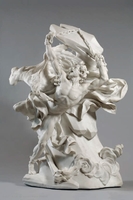 Prometheus, Chained to Mount Caucus, has his Liver Devoured by an Eagle “The Titan Prometheus, protector of men, stole fire from Mount Olympus. Furious, Zeus inflicted a terrible and cruel punishment on him. He chained him to the summit of Mount Caucasus, where an eagle came daily to peck at his liver, which constantly replenished itself. Prometheus, straining his every muscle, screams in agony. The instrument of his crime, the torch, lies at his feet.”
Prometheus, Chained to Mount Caucus, has his Liver Devoured by an Eagle “The Titan Prometheus, protector of men, stole fire from Mount Olympus. Furious, Zeus inflicted a terrible and cruel punishment on him. He chained him to the summit of Mount Caucasus, where an eagle came daily to peck at his liver, which constantly replenished itself. Prometheus, straining his every muscle, screams in agony. The instrument of his crime, the torch, lies at his feet.” -
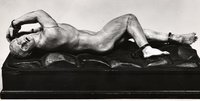 Untitled statuette “Statuette; ivory; carved; a nude figure in the form of Prometheus, who is shackled and chained at his wrists and ankle to a rock; the chains and rock are made of bronze, attached to a rectangular base by means of a screw with a washer in the form of a coin.”
Untitled statuette “Statuette; ivory; carved; a nude figure in the form of Prometheus, who is shackled and chained at his wrists and ankle to a rock; the chains and rock are made of bronze, attached to a rectangular base by means of a screw with a washer in the form of a coin.”